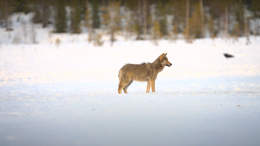“The concentration of wolf packs in some European regions has become a real danger for livestock and potentially also for humans,” European Commission President Ursula von der Leyen said in 2023, after her family pony — Dolly — was killed by a wolf in Saxony. “I urge local and national authorities to take action where necessary.”
And act they did. By the end of the year, von der Leyen’s Commission, the primary executive arm of the European Union, submitted a proposal to change the conservation status of the wolf from “strictly protected” to simply “protected.” This change, which was approved in early 2025, not only offers EU member states greater autonomy and flexibility in how they choose to manage their respective wolf populations, but also lowers restrictions on hunting — a practice which had been largely prohibited since 1979, when comprehensive rehabilitation endeavors first began.
While wolf populations in Europe have recovered significantly since the 1970s — their numbers are thought to have increased 60% over the past decade alone — researchers warn that policymaking on both the national and European level is increasingly motivated by personal and political interests as opposed to scientific data, leading to ineffective governance and potentially unnecessary environmental destruction.
“Wolves are doing well over most of Europe, despite poaching, culling, and so many other attempts to control them,” Luigi Boitani, professor emeritus at the University of Rome and one of the world’s foremost experts on wolf conservation, tells The Revelator via email.
View this post on Instagram
At the same time, he contends, systematic killings in countries like Sweden and France are “keeping population growth well under the potentiality of the species and not at all reducing the level of depredation on livestock.”
Rather, he says, such measures “are good only to satisfy the prejudices of incompetent policy makers.”
From Decline to Growth
Up until the late 18th century, wolves lived across Europe — from the British Isles to the Baltics and Balkans. Deforestation, agriculture, and commercial and recreational hunting — accelerated by the Industrial Revolution — caused populations to shrink and disperse. Eurasian wolves (Canis lupus lupus, a subspecies related to North America’s gray wolf, Canis lupus) disappeared from countries where they had once been a relatively common sight, not to mention important cultural symbols.
Wolf populations did not recover until the late 1970s, when the Bern Convention — also known as the Convention on the Conservation of European Wildlife and Natural Habitats — turned wildlife conservation into a legal obligation for all members of the Council of Europe, and later the EU. Hunting limitations on prey species like boar and deer, as well as investment in nonlethal livestock protection, paved the way for the wolf’s return to the point that the species can once again be found in every mainland EU country.
While some endangered species have proven difficult to monitor, the Eurasian wolf is not one of them.
“There may be some misconceptions about wolves, such as their impact on livestock or game, or their risk to humans,” says John Linnell, a professor at the University of Inland Norway’s Department of Forestry and Wildlife Management, “but data on density and numbers is actually very good — especially when compared to 99% of other species.”
Tried and tested monitoring methods — including analysis of animal remains, camera trapping, and snow tracking — paint a reliable picture of wolf population size and distribution. A 2024 report on large carnivores by the European Commission estimated that its member states were home to a total of around 23,000 wolves, with some of the biggest populations residing in Romania, Italy, Spain, Greece, Poland, Germany, and France. That’s more than in the U.S., whose wolf population is estimated at around 16,500.
Although that report found some debate about the extent to which these impressive statistics can be attributed to the increasing scope and sophistication of wolf-related research, many experts agree that the data is sound enough to inform policymaking.
The problem is: it doesn’t.
Blinded by Preconceptions
“We are talking about a whole continent here,” Linnell stresses, “not a small study area. And while we can’t hold our hands over our hearts and swear that each number is correct, we do have a very good idea as to what is going on. How scientific data is used or abused in politics — if used at all — that’s a totally different story.”
Take the European Commission’s campaign to alter the wolf’s conservation status. The impetus for this campaign stemmed from a personal incident — the death of Dolly, the 30-year-old pet pony — not scientific data, which should have been the standard.
In fact, the decision ignored scientific data.
In 2024 University of León Department of Biodiversity professor Andrés Ordiz and co-authors discussed the then-ongoing debate over wolf management in a paper titled “Large carnivore management at odds: Science or prejudice?” They noted that the Commission assumed wolves had come to pose a serious threat to people — despite the fact that, as they wrote, “the risk of a wolf attack is so low that it cannot even be calculated.”
Time and again the Commission relied on arguments that ignored or contradicted scientific evidence. In a press release, it warned that the risk of attacks was particularly high for those living near a “concentration of wolf packs” — a “vague idea” unknown to research, according to the Ordiz paper, which said the phrase “likely refers to core areas of wolf populations where densities are higher,” although that would make the statement incorrect, as “conflicts are more likely to occur at the edges” of such areas, where wolves are seldom seen.
Instead of consulting researchers, the Commission launched an online survey that collected data from non-scientific organizations. It also conducted public-opinion polls in 24 EU member states. Surprisingly, large majorities from both urban and rural areas (71% and 68% respectively) come out in favor of maintaining rather than decreasing protection — data which also seem to have been ignored by the Commission.
Considering that past attempts to elevate the wolf’s conservation status have been rejected due to a lack of published scientific evidence, the Ordiz paper reached the sobering conclusion that the standards for decreasing environmental protections in the EU today appear to be much lower than those for increasing them.
The Future of European Wolves
Two questions remain: How will the decision to change the wolf’s conservation status impact European populations? And if this decision was not based on scientific research, what would a policy that’s actually based on science look like?
Regarding the first question, some researchers suspect that the change will have little-to-no effect.
“It is very difficult to reduce wolf populations, especially if regulations vary in each country,” says L. David Mech, an adjunct professor at the University of Minnesota’s Department of Fisheries, Wildlife and Conservation Biology and founder of the International Wolf Center. “Wolves easily disperse across borders, so reductions in one area can easily be compensated by dispersal and reproduction from neighboring countries.”
Boitani, meanwhile, fears the EU could undo some of the progress it has made during the previous decades, concluding that “wolf numbers might decrease at continental scale” with “huge differences” at the local level, depending on the actions of individual countries.
View this post on Instagram
Finally, Linnell’s outlook is slightly more positive. “There is no automatic reason that wolf populations will decline,” he says, noting that populations in countries where the wolf was already subject to less stringent conservation requirements — like Estonia, Latvia, Lithuania, Poland, and Greece — did not fare worse than those of other countries.
“Everything depends on how member states utilize their new flexibility and the increased responsibility that goes with it,” he explains. “A more liberal use of lethal control also requires more extensive monitoring of populations and continued investment in livestock protection measures.”
Linnell says he hopes the downlisting will lower some of the social and political conflicts among rural stakeholders. “However, if countries do not take this new responsibility seriously it could lead to an escalation in conflicts with environmentalists. The devil will be in the details of implementation.”
Ironically, the second question — what policy informed by science as opposed to sentiment would look like — does not produce a consensus either.
“A well-established reason to conserve large carnivores is the role they play in nature,” Ordiz tells The Revelator via email. “They are keystone species — species that can play a larger ecological function than their low numbers may let us think. They are apex predators, placed at the uppermost corner of trophic cascades, and thus by nature they are largely free of predation. If management was aimed at favoring that ecological role, human intervention of large carnivore populations should be kept at a minimum. Carnivores would not need to ‘look over their shoulder’ and run away from human persecution.”
In keeping with his previous answer, Linnell does not take issue with the change in conservation status per se, which need not negatively impact wolf populations, but the flawed decision-making process behind it.
“The problem with the recent downlisting of wolves,” he says, “is that there were no clear criteria set for if wolves could or should be downlisted. Studies that had previously been used to justify not downlisting wolves were suddenly used to support downlisting, and there were no real structured processes to identify how science, and which science, should have been used to guide the process.”
Linnell adds, “I hope that the EU learns from this process so that future proposals for changes … can be conducted in a much more structured manner.”

Previously in The Revelator:
19 Books About Wolves


